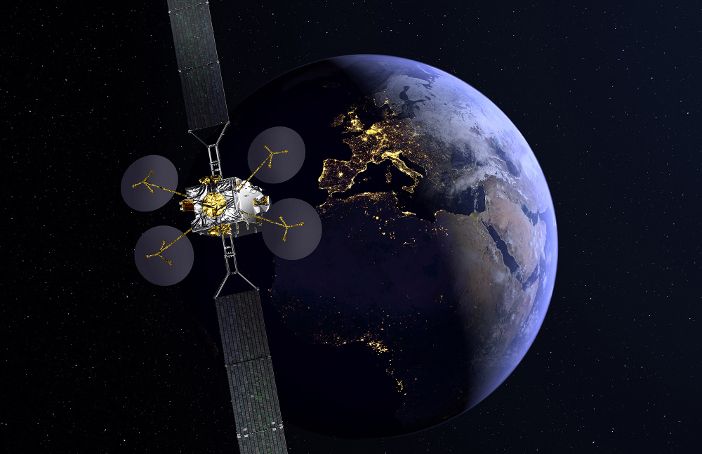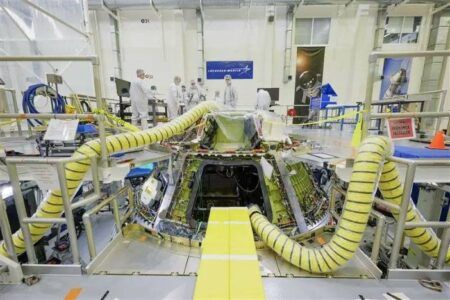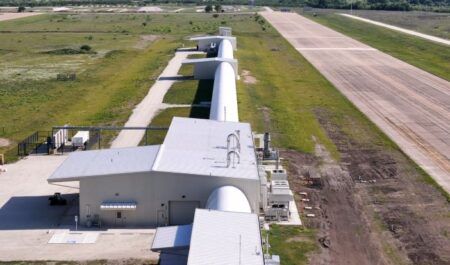The first electric satellite propulsion system to be entirely designed and built in the UK is in the final stages of manufacturing and should be shipped out before the end of the year.
The Xenon Propulsion System (XPS) module is a key part of Thales Alenia Space’s Spacebus platform for geostationary telecommunications satellites.
Electric propulsion, which uses and is often called “ion thrusters”, is increasingly being used by the commercial space industry. Thales Alenia Space joins a handful of companies around the world capable of producing this type of propulsion system, including Airbus Defence and Space and Boeing.
The first XPS propulsion module was designed in Harwell, Oxfordshire, and built and tested in Belfast in Northern Ireland over the last six months. Engineers in Belfast have still to assemble the xenon tanks and the connect them to the thrusters before it is shipped.
The electric propulsion system will go to a Thales Alenia Space facility in Cannes, France, to be integrated into Eutelsat’s Konnect satellite before the end of 2018. The satellite will then be tested before its launch by a SpaceX rocket toward the end of next year.
The satellite will then be raised into its geostationary orbit using its ion thrusters, slowly spiraling upward over four weeks (approximately). Once in orbit it will remain in position for at least 15 years using the electric propulsion system.
Ben Olivier, CEO of Thales Alenia Space UK, said, “The module is the first all-electric propulsion system designed and built in the UK. It’s 1.8m high and 3.6m wide.
“Fully fueled it weighs almost 2 tons and can accelerate a 7-ton satellite at a steady speed of 3km/s.
“It’s a big, impressive piece of kit worth millions.”
Extensive testing
Around 50 engineers at Thales Alenia Space have worked on the development program for the electric propulsion system since 2015.
Olivier said, “Space is a high integrity industry, so we test at component and system level. A lot of the testing was about surviving the launch – ensuring the propulsion system can cope with the load inputs and the thermal variation.
“We did a lot of thermal vacuum testing and pressurized proof testing of the titanium pipework to 100bar. That’s done in a Thales facility separate from the factory for safety reasons.
“We have also tested the thrusters and the drive electronics extensively in a vacuum chamber, to make sure its thrusting in the right way and can handle the high voltage.”
The all-electric benefit
Electric propulsion was first used by spacecraft in the 1960s. The propulsion method uses an inert gas, usually Xenon, which is ionized and accelerated using electricity produced by solar panels. The heated gas expands out of the thruster.
In contrast to chemical propulsion, electric propulsion produces less thrust, around 1N compared with 400N. Whereas chemical propulsion uses short bursts of thrust for maneuvering spacecraft, electric propulsion uses a long, slow, continuous thrust that builds up speed in the satellite over time.
The main advantage to electric propulsion systems is that they weigh less than chemical propulsion systems and their fuel. Station-keeping can also be achieved for as long as is required. “You save on the cost of the launcher and enable the satellites to last longer,” Olivier said.
“There will be a need for both types of propulsion in the future, but electric propulsion will become the mainstream and replace chemical propulsion in most cases. It enables longer missions and more options with the launch vehicle.”
First of two
Yohann Leroy, Eutelsat’s deputy CEO and chief technical officer, said, “This marks the first of a two-part series, with two satellites in construction by Thales Alenia Space for Eutelsat: Konnect and Konnect VHTS. This industrial approach for the XPS modules, spearheaded by the UK space industry, will be rolled out to both programs.”
Thales Alenia Space is a joint venture between Thales (67%) and Leonardo (33%). The Spacebus platform is also supported jointly by the European Space Agency’s (ESA) Advanced Research in Telecommunication Systems program and France’s space agency CNES.





